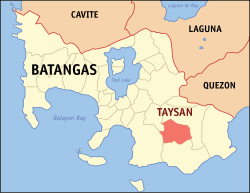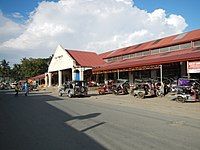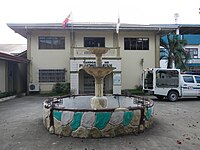Taysan
Taysan | |
|---|---|
| Municipality of Taysan | |
 | |
 Seal | |
 Map of Batangas with Taysan highlighted | |
 Taysan Location within the Philippines | |
| Coordinates: 13°47′N 121°12′E / 13.78°N 121.2°ECoordinates: 13°47′N 121°12′E / 13.78°N 121.2°E | |
| Country | Philippines |
| Region | Calabarzon |
| Province | Batangas |
| District | 4th district |
| Founded | April 24, 1919 [1] |
| Barangays | 20 (see Barangays) |
| Government | |
| • Type | Sangguniang Bayan |
| • Mayor | Grande P. Gutierrez |
| • Vice Mayor | Marianito G. Perez |
| • Representative | Lianda B. Bolilia |
| • Municipal Council | Members |
| • Electorate | 26,530 voters (2019) |
| Area | |
| • Total | 93.62 km2 (36.15 sq mi) |
| Elevation | 196 m (643 ft) |
| Highest elevation | 977 m (3,205 ft) |
| Lowest elevation | 31 m (102 ft) |
| Population (2020 census) [4] | |
| • Total | 40,146 |
| • Density | 430/km2 (1,100/sq mi) |
| • Households | 8,479 |
| Economy | |
| • Income class | 2nd municipal income class |
| • Poverty incidence | 13.00% (2015)[5] |
| • Revenue | ₱187,545,905.50 (2020) |
| • Assets | ₱525,036,553.79 (2020) |
| • Expenditure | ₱166,230,858.12 (2020) |
| • Liabilities | ₱173,113,937.86 (2020) |
| Service provider | |
| • Electricity | Batangas 2 Electric Cooperative (BATELEC 2) |
| Time zone | UTC+8 (PST) |
| ZIP code | 4228 |
| PSGC | |
| IDD : area code | +63 (0)43 |
| Native languages | Tagalog |
Taysan, officially the Municipality of Taysan (Tagalog: Bayan ng Taysan), is a 2nd class municipality in the province of Batangas, Philippines. According to the 2020 census, it has a population of 40,146 people. [4]
Geography[]
Taysan is located at 13°47′N 121°12′E / 13.78°N 121.2°E.
According to the Philippine Statistics Authority, the municipality has a land area of 93.62 square kilometres (36.15 sq mi) [6] constituting 3.00% of the 3,119.75-square-kilometre- (1,204.54 sq mi) total area of Batangas.
Taysan is bordered on the north by Rosario and Ibaan, east by a portion of Rosario, west by Batangas City, and south by Lobo.
Barangays[]
Taysan is politically subdivided into 20 barangays.[7]
| PSGC | Barangay | Population | ±% p.a. | |||
|---|---|---|---|---|---|---|
| 2020 [4] | 2010 [8] | |||||
| 041032001 | Bacao | 2.3% | 918 | 970 | −0.57% | |
| 041032002 | Bilogo | 5.6% | 2,252 | 2,070 | 0.87% | |
| 041032003 | Bukal | 3.9% | 1,554 | 1,448 | 0.73% | |
| 041032004 | Dagatan | 7.7% | 3,078 | 2,667 | 1.48% | |
| 041032005 | Guinhawa | 3.3% | 1,327 | 1,194 | 1.09% | |
| 041032006 | Laurel | 4.3% | 1,739 | 1,658 | 0.49% | |
| 041032007 | Mabayabas | 5.6% | 2,264 | 2,072 | 0.92% | |
| 041032008 | Mahanadiong | 4.8% | 1,908 | 1,741 | 0.95% | |
| 041032009 | Mapulo | 7.7% | 3,084 | 2,850 | 0.81% | |
| 041032010 | Mataas na Lupa | 3.6% | 1,452 | 1,540 | −0.60% | |
| 041032011 | Pag‑Asa | 6.1% | 2,468 | 2,293 | 0.76% | |
| 041032012 | Panghayaan | 3.2% | 1,286 | 1,230 | 0.46% | |
| 041032013 | Piña | 3.8% | 1,525 | 1,462 | 0.43% | |
| 041032014 | Pinagbayanan | 6.5% | 2,625 | 2,310 | 1.32% | |
| 041032015 | Poblacion East | 2.1% | 846 | 818 | 0.35% | |
| 041032016 | Poblacion West | 2.4% | 976 | 901 | 0.83% | |
| 041032017 | San Isidro | 6.4% | 2,581 | 2,401 | 0.75% | |
| 041032018 | San Marcelino | 4.5% | 1,807 | 1,700 | 0.63% | |
| 041032019 | Santo Niño | 6.2% | 2,501 | 2,303 | 0.85% | |
| 041032020 | Tilambo | 4.5% | 1,816 | 1,729 | 0.51% | |
| Total | 40,146 | 35,357 | 1.32% | |||
Climate[]
| Climate data for Taysan, Batangas | |||||||||||||
|---|---|---|---|---|---|---|---|---|---|---|---|---|---|
| Month | Jan | Feb | Mar | Apr | May | Jun | Jul | Aug | Sep | Oct | Nov | Dec | Year |
| Average high °C (°F) | 26 (79) |
27 (81) |
29 (84) |
31 (88) |
31 (88) |
30 (86) |
29 (84) |
28 (82) |
28 (82) |
28 (82) |
28 (82) |
26 (79) |
28 (83) |
| Average low °C (°F) | 20 (68) |
20 (68) |
20 (68) |
21 (70) |
23 (73) |
24 (75) |
24 (75) |
23 (73) |
23 (73) |
22 (72) |
22 (72) |
21 (70) |
22 (71) |
| Average precipitation mm (inches) | 52 (2.0) |
35 (1.4) |
27 (1.1) |
27 (1.1) |
82 (3.2) |
124 (4.9) |
163 (6.4) |
144 (5.7) |
145 (5.7) |
141 (5.6) |
100 (3.9) |
102 (4.0) |
1,142 (45) |
| Average rainy days | 12.0 | 8.1 | 8.8 | 9.7 | 17.9 | 22.6 | 26.2 | 24.5 | 24.6 | 22.0 | 16.7 | 14.9 | 208 |
| Source: Meteoblue [9] | |||||||||||||
Demographics[]
| Year | Pop. | ±% p.a. |
|---|---|---|
| 1903 | 3,386 | — |
| 1939 | 8,526 | +2.60% |
| 1948 | 10,318 | +2.14% |
| 1960 | 11,750 | +1.09% |
| 1970 | 14,999 | +2.47% |
| 1975 | 17,075 | +2.63% |
| 1980 | 19,370 | +2.55% |
| 1990 | 22,508 | +1.51% |
| 1995 | 26,504 | +3.11% |
| 2000 | 29,836 | +2.57% |
| 2007 | 33,454 | +1.59% |
| 2010 | 35,357 | +2.03% |
| 2015 | 38,007 | +1.39% |
| 2020 | 40,146 | +1.08% |
| Source: Philippine Statistics Authority [10] [8] [11][12] | ||
In the 2020 census, Taysan had a population of 40,146. [4] The population density was 430 inhabitants per square kilometre (1,100/sq mi).
Economy[]
| Poverty Incidence of Taysan | |
| Source: Philippine Statistics Authority[13][14][15][16][17][18] | |
Gallery[]
Municipal hall

Public market
A street in town
Nuestra Señora dela Merced Parish Church
References[]
- ^ "Jenifer Conti Gualter".
- ^ Municipality of Taysan | (DILG)
- ^ "2015 Census of Population, Report No. 3 – Population, Land Area, and Population Density" (PDF). Philippine Statistics Authority. Quezon City, Philippines. August 2016. ISSN 0117-1453. Archived (PDF) from the original on May 25, 2021. Retrieved July 16, 2021.
- ^ a b c d Census of Population (2020). "Region IV-A (Calabarzon)". Total Population by Province, City, Municipality and Barangay. PSA. Retrieved 8 July 2021.
- ^ https://psa.gov.ph/sites/default/files/City%20and%20Municipal-level%20Small%20Area%20Poverty%20Estimates_%202009%2C%202012%20and%202015_0.xlsx; publication date: 10 July 2019; publisher: Philippine Statistics Authority.
- ^ "Province: Batangas". PSGC Interactive. Quezon City, Philippines: Philippine Statistics Authority. Retrieved 12 November 2016.
- ^ "Municipal: Taysan". PSGC Interactive. Quezon City, Philippines: Philippine Statistics Authority. Retrieved 8 January 2016.
- ^ a b Census of Population and Housing (2010). "Region IV-A (Calabarzon)". Total Population by Province, City, Municipality and Barangay. NSO. Retrieved 29 June 2016.
- ^ "Taysan: Average Temperatures and Rainfall". Meteoblue. Retrieved 5 May 2020.
- ^ Census of Population (2015). "Region IV-A (Calabarzon)". Total Population by Province, City, Municipality and Barangay. PSA. Retrieved 20 June 2016.
- ^ Censuses of Population (1903–2007). "Region IV-A (Calabarzon)". Table 1. Population Enumerated in Various Censuses by Province/Highly Urbanized City: 1903 to 2007. NSO.
- ^ "Province of Batangas". Municipality Population Data. Local Water Utilities Administration Research Division. Retrieved 17 December 2016.
- ^ "Poverty incidence (PI):". Philippine Statistics Authority. Retrieved 28 December 2020.
- ^ https://psa.gov.ph/sites/default/files/NSCB_LocalPovertyPhilippines_0.pdf; publication date: 29 November 2005; publisher: Philippine Statistics Authority.
- ^ https://psa.gov.ph/sites/default/files/2003%20SAE%20of%20poverty%20%28Full%20Report%29_1.pdf; publication date: 23 March 2009; publisher: Philippine Statistics Authority.
- ^ https://psa.gov.ph/sites/default/files/2006%20and%202009%20City%20and%20Municipal%20Level%20Poverty%20Estimates_0_1.pdf; publication date: 3 August 2012; publisher: Philippine Statistics Authority.
- ^ https://psa.gov.ph/sites/default/files/2012%20Municipal%20and%20City%20Level%20Poverty%20Estima7tes%20Publication%20%281%29.pdf; publication date: 31 May 2016; publisher: Philippine Statistics Authority.
- ^ https://psa.gov.ph/sites/default/files/City%20and%20Municipal-level%20Small%20Area%20Poverty%20Estimates_%202009%2C%202012%20and%202015_0.xlsx; publication date: 10 July 2019; publisher: Philippine Statistics Authority.
External links[]
| Wikimedia Commons has media related to Taysan. |
- Municipalities of Batangas
- Calabarzon geography stubs





